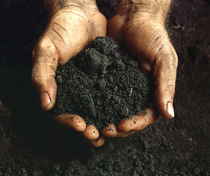
Mississippi Symbols
Mississippi State Soil
Natchez Silt Loam

Coarse-silty, mixed, superactive, thermic Typic Eutrudepts:
Adopted on March 13, 2003
On March 13, 2003, Mississippi lawmakers designated the Natchez Silt Loam (Typic Eutrudepts) was designated the State Soil of Mississippi,
Chapter
360, General Laws of Mississippi 2002.
In 1988, the Professional Soil Classifiers Association of Mississippi selected Natchez silt loam soil to represent the soil resources of the State. These soils exist on 171,559 acres (0.56% of state) of landscape in Mississippi.
Mississippi State Soil: Natchez Silt Loam
 Natchez soils are
along the bluffs of the Mississippi Delta and are throughout the full length of the state.
Natchez soils are
along the bluffs of the Mississippi Delta and are throughout the full length of the state.In 1988, the Professional Soil Classifiers Association of Mississippi selected Natchez silt loam to represent the soil resources of the state. Natchez soils occur on 171,559 acres in Mississippi.
Natchez soils formed in very deep loess under a woodland environment and a climate that was warm and humid. These soils are used mostly for woodland and pasture. They are fertile and have a site index of 90 to 100 for loblolly pine and 105 for cherrybark oak, ash, and sweetgum. In less sloping areas, pasture and row crops are grown and the soils are very productive when good management is applied.
Natchez soils are in the Inceptisols soil order. Inceptisols soils have developed in relatively young material that have an Ochric epipedon overlying a Cambic horizon. This soil is developed in very deep wind blown loess that is rich in weatherable minerals. The term coarse-silty indicates that the subsoil has less than 18 percent clay with less than 15 percent sand coarser than very fine. The term mixed suggests that no one mineral is over 60 percent. Thermic refers to an average annual soil temperature between 15-22 degrees C(59-72 degrees F) and differs more than 5 degrees C between winter and summer at50 cm (20 inches) below the surface.
Natchez soils are on strongly sloping to very steep hillsides in the highly dissected parts of the bluff hills that border the Mississippi Delta floodplains. They formed in silty loess material that ranges from strongly acid to neutral in the upper part and neutral to slightly alkaline in lower parts. Average annual precipitation is 52 inches. Average annual air temperature is 63 degrees F. The soil has developed in the upper Pleistocene age material.
Natchez Soil Profile
Surface layer: dark grayish brown silt loam
Subsurface layer: brown silt loam
Subsoil: yellowish brown silt loam
Substratum: yellowish brown silt loam
NATCHEZ SERIES
The Natchez series consists of deep, well drained soils that formed in thick deposits of loess. Permeability is moderate, and runoff is rapid to very rapid. These strongly sloping to very steep soils are on hillsides in the highly dissected bluff hills section of the Southern Mississippi Silty Uplands that border the alluvial plains of the Mississippi River and its tributaries. Slope ranges from 12 to 60 percent.
TAXONOMIC CLASS: Coarse-silty, mixed, superactive, thermic Typic Eutrudepts
SERIES ESTABLISHED: DeSoto County, Mississippi; 1955.
Mississippi Law
The law designating the Natchez silt loam as the official Mississippi state soil is found in the Mississippi Code, Title 3, Chapter 3, Section 3-3-45.
TITLE 3. STATE SOVEREIGNTY, JURISTICTION AND HOLIDAYS.
CHAPTER 3. STATE BOUNDARIES, HOLIDAYS, AND STATE EMBLEMS.
SEC. 3-3-45
§ 3-3-45. State soil.
Natchez silt loam (coarse-silty, mixed, superactive, thermic, Typic Eutrudepts) is hereby designated as the official state soil of Mississippi.
Sources: Laws, 2003, ch. 360, § 1, eff from and after passage (approved Mar. 13, 2003.)






